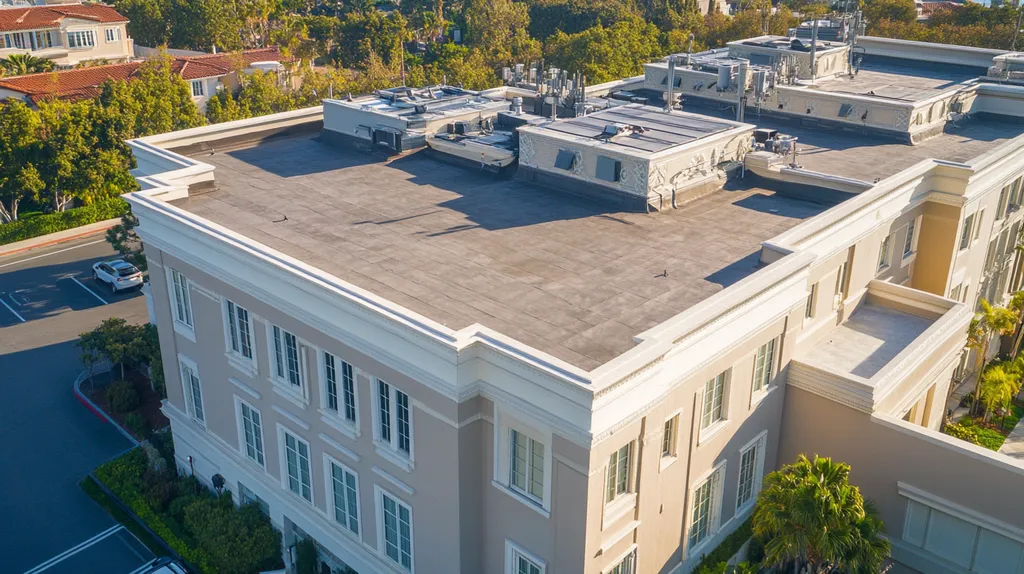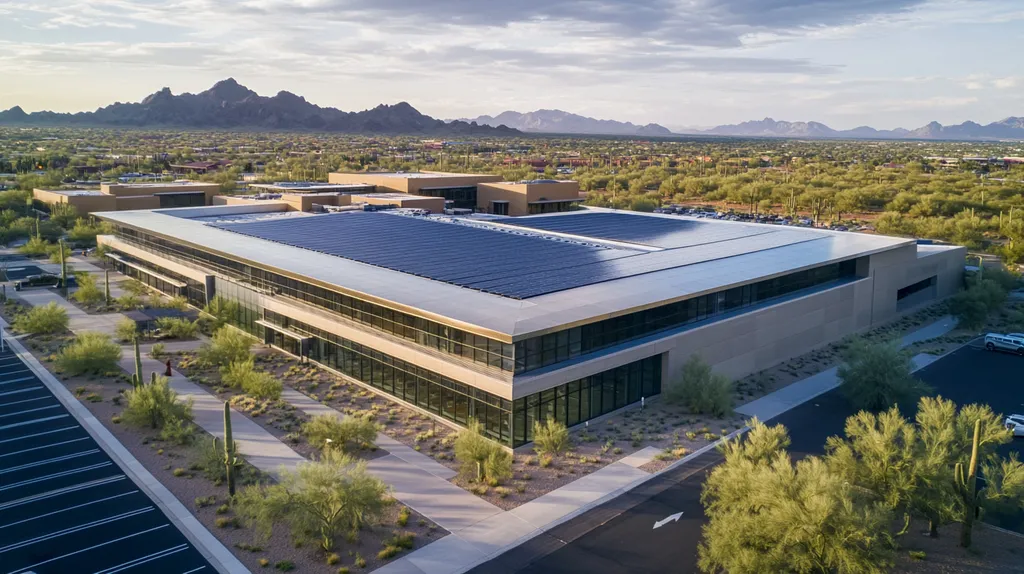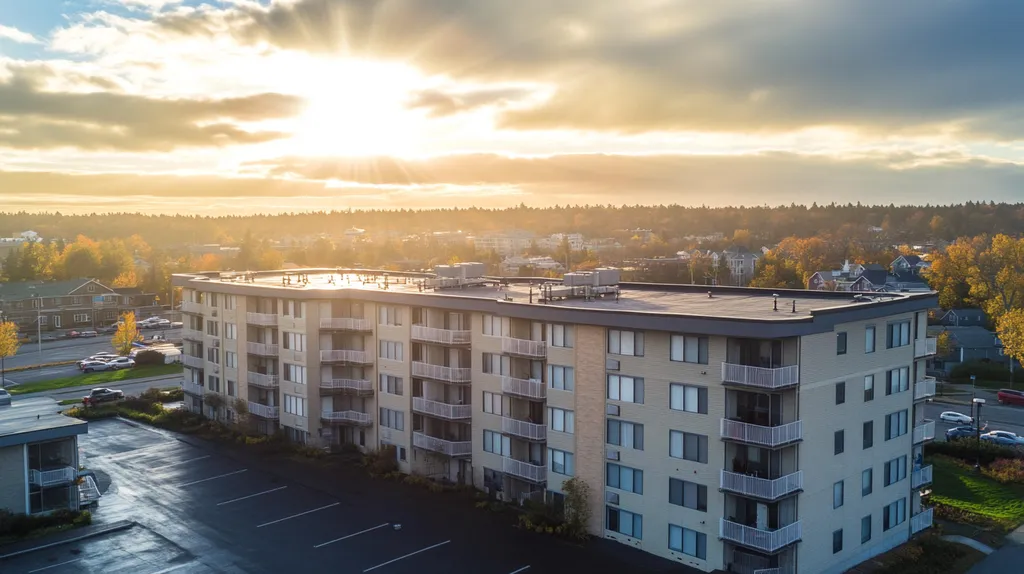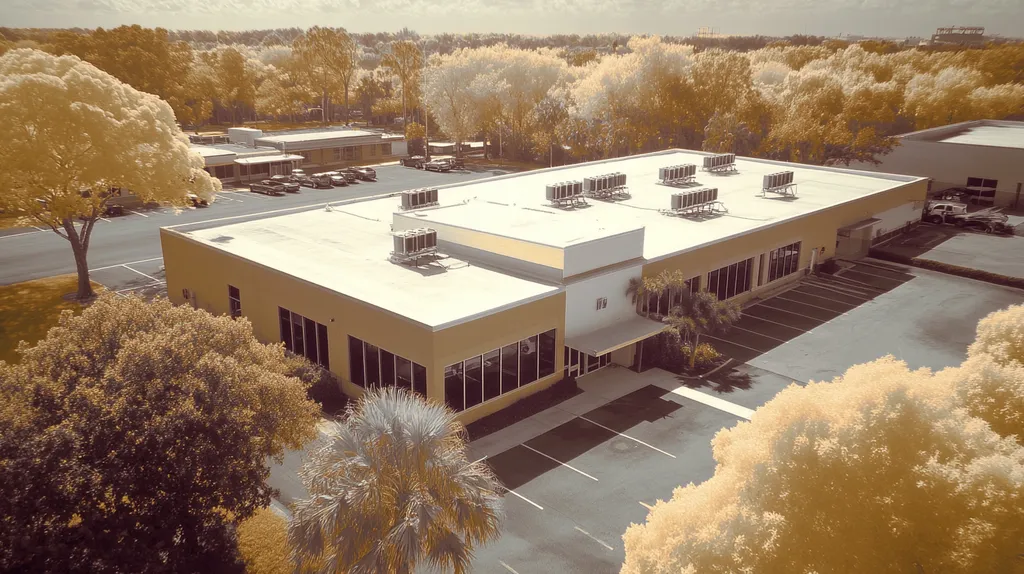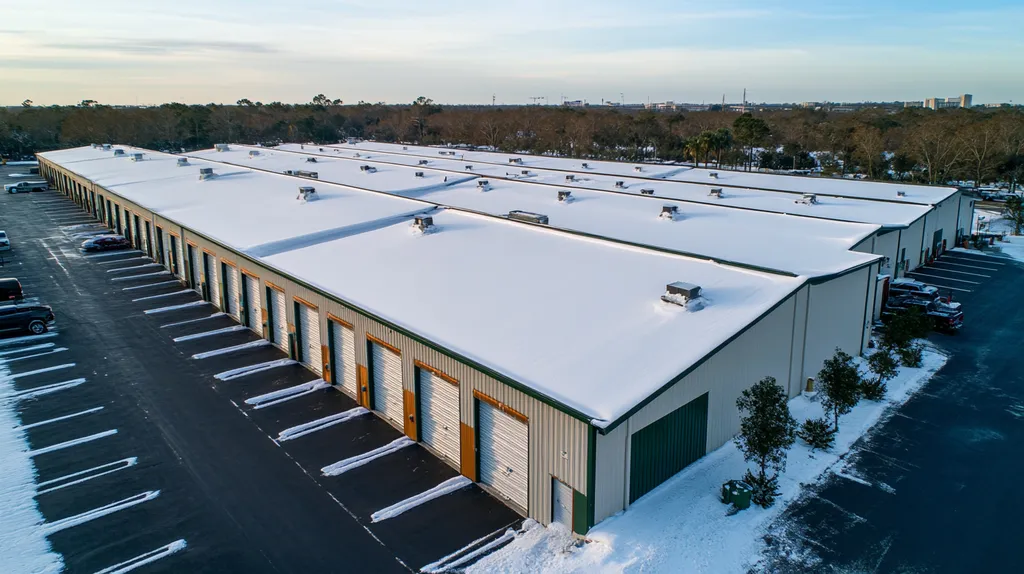When industrial roof emergencies strike, every minute of delay can cost facilities thousands in damages and lost productivity. Current industry data reveals that 65% of commercial properties experience response times exceeding critical 4-hour windows, leading to preventable structural deterioration and operational disruptions.
The conventional approach to emergency roof response, characterized by limited coverage and basic protocols, fails to meet the demands of modern industrial facilities.
This analysis examines systemic failures in current emergency response practices, supported by extensive data, while presenting actionable solutions for property owners and facility managers seeking to protect their assets.
SECTION 1: CURRENT PRACTICES
In the demanding world of industrial operations, every second matters during a roofing emergency. Unfortunately, existing practices often leave property owners facing unnecessary delays. A recent report warns that nearly 30% of industrial roofing emergencies lead to expensive damages that timely intervention could prevent. Recognizing and understanding these current practices is essential for property owners and facility managers aiming to protect their assets and minimize costs.
Standard Response Times and Delays
Response times for industrial roof emergencies generally fall within a disappointing range of 24 to 48 hours. This waiting period can be particularly detrimental during severe weather events, which often exacerbate existing problems. Many roofing companies prioritize requests on a first-come, first-served basis, causing businesses in urgent need of help to face significant delays.
Additionally, travel times for contractors can vary wildly based on location. For facilities situated in remote areas, assistance may be delayed beyond 72 hours due to logistic constraints. This increased wait can further worsen damage, leading to inflated repair costs and extended operational downtime.
Facilities managers often feel pressured to act swiftly in emergencies, yet their options are frequently limited. Many must rely on local contractors who may lack the necessary tools or expertise for effective assessment and repair. This reactive approach increases both downtime and repair expenses, underscoring the need for a more efficient and responsive emergency framework.
To improve the current situation, the industry must critically reevaluate standard practices, focusing on enhancing speed and operational efficiency. Streamlined processes can significantly shift the troublesome status quo.
Limited Geographic Coverage
Many roofing companies are confined to specific geographic areas, which restricts their ability to quickly respond to emergencies located outside their designated zones. This limited coverage can severely disadvantage industrial properties during crises, leaving facility managers struggling to find local service providers capable of addressing urgent requests.
The problem escalates in high-demand industrial regions where adverse weather prompts a surge of service requests, creating a backlog. Property owners often find themselves racing against time, trying to secure qualified contractors who can access their locations without extensive delays.
This geographic limitation forces businesses into tough choices, such as hiring less qualified contractors or accepting wait times that could worsen their situations. Consequently, this lack of coverage may lead to increased liabilities, as property owners could be held responsible for damages stemming from delayed repairs.
To navigate these challenges, companies can explore partnerships with professionals outside their areas who offer rapid response services. This strategy not only expands their service options but also significantly boosts their readiness for emergencies.
Basic Emergency Assessment Protocols
Current emergency assessment protocols often fall short, lacking the depth necessary to accurately evaluate roof damage. Many response teams conduct only superficial inspections, risking the omission of critical issues that could lead to further complications. This inadequate evaluation leaves property owners exposed to escalating damages that may develop unexpectedly.
Standard protocols usually involve an initial visual inspection, which may miss hidden leaks or structural vulnerabilities. Without advanced diagnostic technologies, contractors may struggle to gain a comprehensive understanding of a roof’s condition, culminating in suboptimal repair strategies. This oversight can lead to recurring issues and spiraling costs.
The presence of inadequate assessment practices significantly undermines effective emergency response. Facilities managers frequently find themselves readdressing identical problems due to a lack of insight into the true state of their roofs.
Implementing more structured and detailed assessment protocols, particularly those that incorporate technological advances, can dramatically improve evaluation accuracy. Utilizing tools such as infrared thermography or drone inspections enables contractors to perform thorough damage analyses, leading to more effective repair methods.
SECTION 2: SYSTEMIC ISSUES
When industrial roofs sustain damage, quick action is crucial to minimize disruption and financial loss. Emergency response times can directly affect a company’s operations and safety protocols. A 24-hour delay in addressing a leaking warehouse roof can result in ruined stock and interrupted workflows. It’s essential for property owners and facility managers to understand the systemic issues contributing to these delays: inadequate resource allocation, lack of 24/7 availability, and insufficient training for emergency situations.
Inadequate Resource Allocation
Industrial property owners often grapple with poorly allocated resources when faced with roofing emergencies. Budget restrictions frequently limit access to skilled labor and essential materials. As a result, immediate maintenance requirements may exceed available resources, leading to painful delays.
When a roofing crisis occurs, the sheer urgency can surpass the capacity of existing resources, generating feelings of frustration. This lack of readiness can delay necessary actions, worsening the damage and inflating repair costs.
The absence of pre-allocated funds for emergency repairs commonly results in frantic attempts to patch together solutions during a crisis. This reactive strategy neglects the proactive planning that could prevent larger issues. If rapid repair services are not readily available, businesses risk significant operational setbacks.
Lack of 24/7 Availability
One alarming gap in industrial roofing services is the lack of 24/7 availability. Roof-related issues can strike at any time, making a responsive team essential for minimizing damage. Unfortunately, many contractors limit their services to regular business hours, leaving property managers exposed to emergencies.
For example, if rain causes a leak to develop overnight, the absence of immediate assistance can lead to extensive water damage. Prolonged exposure to leaks poses risks not just to physical assets but also to the structural integrity of facilities, resulting in costly repairs that could have been averted.
This lack of around-the-clock support can also compromise employee safety. Structural failures or hazardous conditions may arise, creating dangerous environments if not addressed promptly. The direct correlation between limited emergency availability and extended response times heightens the overall risks for businesses.
Insufficient Training for Emergency Situations
Another pressing factor in the slow emergency response for industrial roofs is the inadequate training of staff to handle roofing crises. Many property managers lack the knowledge and skills necessary for immediate responses to roof-related emergencies, which can lead to critical delays in decision-making.
Without thorough training, employees may fail to recognize warning signs or accurately assess the level of damage. This communication breakdown with contractors or emergency services only compounds response times. A well-trained team is fundamental for not only acting quickly but also minimizing costs and resources lost during an emergency.
Moreover, the false sense of security that arises from insufficient training can create dangerous situations, heightening the risk of accidents and injuries. Investing in comprehensive training empowers staff to respond decisively and efficiently, greatly improving emergency outcomes. A proactive approach to employee preparedness is vital for safeguarding both assets and personnel.
SECTION 3: MISSED OPPORTUNITIES
In the competitive industrial sector, swift responses to roofing emergencies are essential to safeguarding assets and reputation. Ignoring preventive maintenance can lead to disastrous failures, costing businesses not only financially but also in credibility. In 2022, an estimated $30 billion in losses were attributed to roofing-related incidents. This section delves into three significant areas where opportunities are often missed: preventive maintenance, advanced technologies, and communication challenges.
Neglect of Preventive Maintenance
Preventive maintenance is frequently perceived as an optional cost instead of a critical investment. Many industrial facility managers, consumed by daily operations, may overlook the necessity of regular roof inspections and maintenance. This disregard often transforms minor issues into severe failures, jeopardizing the entire structure’s integrity.
For instance, a small, unnoticed leak can lead to mold growth, extensive water damage, and the need for costly repairs. When scheduled maintenance inspections are ignored, the likelihood of sudden emergency situations significantly increases.
Additionally, data indicates that implementing preventive maintenance can reduce repair costs by up to 50% compared to reactive measures. By prioritizing regular upkeep, businesses not only safeguard their investments but also enhance the lifespan of their roofs.
In summary, addressing these maintenance requirements promptly can substantially impact a company’s financial health and operational efficiency. Allocating resources to preventive strategies helps decrease the risks of unforeseen and costly roofing crises.
Failure to Utilize Advanced Technologies
Even as technology continues to advance, many industrial facilities still depend on outdated methods for roof monitoring and management. This reluctance to adopt modern solutions can critically impair response times during emergencies. Tools such as drones, infrared cameras, and real-time monitoring systems can provide vital data for the early detection of vulnerabilities.
For example, drone technology can uncover damage or wear that might elude the eye during routine inspections. Facilities that harness these advancements can pivot from a reactive stance to a proactive one, substantially curtailing the need for emergency interventions.
Moreover, advanced analytics can identify potential failures by analyzing wear patterns and environmental factors. By not leveraging these technological tools, facility managers risk missing critical maintenance opportunities that could avert emergencies entirely.
Updating operational systems and embracing cutting-edge technologies are indispensable steps for those committed to enhancing roof longevity and reliability. Investing in modern solutions ensures quicker responses and reduced long-term costs.
Inefficient Communication Channels
Effective communication is vital for a swift emergency response; however, many organizations still face challenges rooted in fragmented information and ambiguous protocols. In emergencies, facility managers often struggle to coordinate with roofing contractors or internal teams, which can lead to delayed action.
For instance, when a leak occurs, prompt identification and notification are crucial. If an employee must traverse multiple channels to report the issue, precious time is wasted, leading to further damage. Establishing clear communication pathways can greatly enhance response times.
Furthermore, conducting regular training sessions ensures that all personnel understand communication protocols and emergency procedures. Ineffective communication not only complicates resolution efforts but can also escalate manageable issues into full-scale emergencies.
By streamlining communication and fostering a culture of immediate reporting, organizations can significantly enhance their emergency response capabilities. This proactive approach minimizes disruptions and elevates overall facility management efficiency.
SECTION 4: ROOT CAUSES
The implications of sluggish emergency response times for industrial roofs can be dire. Without prompt action, facilities not only risk significant structural damage but also face escalating repair bills and potential safety hazards. Recent studies indicate that neglecting emergency roofing measures can lead to losses reaching millions, fueled by delayed repairs and environmental degradation. Therefore, identifying and addressing the root causes behind these slow responses is essential to safeguarding both asset integrity and financial stability.
Budget Constraints and Cost-Cutting
Budget limitations often compel facility managers to overlook the critical importance of regular maintenance and emergency preparedness for roofs. In times of financial tightening, roofing systems may receive less attention, leaving them vulnerable and prone to failure during emergencies.
Such cost-cutting measures frequently lead businesses to choose inexpensive roofing materials, lured by the prospect of immediate savings. However, these choices can prove costly in the long run, as the expenses associated with emergency repairs on subpar roofing systems can far exceed initial savings.
Moreover, inadequate funding for emergency response initiatives can significantly delay necessary actions. When resources are not earmarked for quick repairs, property managers may grapple with a response time lag, thereby exposing valuable assets to greater risk during emergencies.
Ultimately, a strategic allocation of budget for roofing maintenance can enhance both the longevity of the roof and the efficiency of emergency protocols.
Regulatory Gaps and Compliance Issues
The regulatory framework governing roofing maintenance and emergency response is often disjointed and inconsistent, leading to confusion for facility managers regarding their obligations. Compliance with local and national standards is essential; however, regulatory gaps can hinder proactive emergency planning.
Frequently, existing guidelines lack comprehensiveness regarding emergency response for industrial roofs. This oversight can diminish the urgency for developing thorough emergency plans or providing necessary staff training.
Additionally, many facilities may adhere to outdated building codes that do not align with today’s best practices. This not only heightens the risk for buildings but also complicates communication during emergencies, as disconnected protocols can lead to chaos at critical moments.
By bridging these regulatory gaps through clear and consistent guidelines, facility managers can take decisive action to enhance emergency responsiveness.
Inadequate Risk Assessment
An ineffective risk assessment process is a significant contributor to prolonged emergency response times. Many facility managers do not adequately identify potential threats that could jeopardize roofing integrity, leaving their emergency plans ill-equipped.
Standard operating procedures often fail to consider unique environmental factors, such as heavy snow or extreme winds. This oversight can lead to unpreparedness when actual emergencies arise, exacerbating damage and delay.
Additionally, not evaluating the condition of roofing materials during regular maintenance can result in unforeseen failures. When vulnerabilities go undetected, facility managers may find themselves scrambling to address emergent issues that could have been anticipated and mitigated.
A comprehensive risk assessment framework is essential for empowering facility managers to actively manage roofing assets, thereby facilitating more timely and effective emergency responses.
DATA DRIVEN EVIDENCE
In the realm of industrial operations, emergency response times for roofing issues can profoundly impact both property value and operational efficiency. Promptly addressing roofing problems is crucial; delays can lead to severe damage, soaring repair expenses, and heightened safety hazards. Research from the National Roofing Contractors Association (NRCA) indicates that properties can experience a staggering 25% value decrease if leaks aren’t repaired within the first 24 hours. This section explores historical response time data, the tangible effects of repair delays on property values, and alarming statistics regarding preventable damages.
Historical Data on Emergency Response Times
Scrutinizing historical emergency response data unveils a troubling pattern within the industrial roofing sector. Historically, average response times for roof repairs have fluctuated between 48 to 72 hours. This lag leaves buildings vulnerable to water intrusions that can cause irreversible damage, highlighting the urgent need for swifter action.
Facilities that manage to respond within 24 hours generally see significantly reduced repair costs. Responding promptly can minimize expenses by up to 40%, showcasing the financial advantages of timely repairs.
A case study from a manufacturing facility revealed that each additional hour of delay equated to roughly $5,000 in damages. This finding underscores the pressing importance of implementing efficient emergency response protocols.
Consequently, the historical data on response times not only illustrates the existing inefficiencies but also serves as a rallying cry for property owners to critically revise their emergency preparedness strategies.
Impact of Delayed Repairs on Property Value
Prolonged delays in repairs can drastically diminish a property’s long-term value. If roofing issues are left unresolved, they can escalate into structural damage and even code violations. Research indicates that properties with lingering roofing problems can see a decline in valuation of up to 25%, as illustrated in real estate assessments.
Furthermore, deteriorating roofs can deter potential buyers and tenants, leading to extended vacancy periods. A property with a leaking roof may also develop a negative reputation, reducing investment interest.
Moreover, safety risks exacerbated by delayed repairs can result in liability claims. Such legal challenges further threaten property value and marketability.
Therefore, understanding the financial ramifications of delayed repairs is essential for property owners committed to protecting their investments.
Statistics on Preventable Damage
Data reveals that a significant proportion of industrial roofing damage is preventable. Industry reports indicate that over 50% of roof leaks could be avoided with prompt inspections and timely repairs. This statistic underscores the critical need for effective emergency response strategies.
Facilities that engage in regular maintenance programs face 70% fewer emergency repair incidents compared to those that skip routine inspections. Preventative measures yield not only cost savings but also increased roof longevity and functionality.
Additionally, research shows that organizations that implement dedicated emergency response plans can reduce damage incidents by nearly 30%. This proactive approach not only protects the roofing structure but also minimizes operational downtime.
In summary, these statistics reaffirm the necessity for property owners to prioritize proactive roofing management in order to avert unnecessary damage and optimize their property’s value.
SECTION 6: ALTERNATIVE SOLUTIONS
In the high-stakes environment of industrial operations, traditional emergency response models for roofing simply do not meet the urgent demands of the industry. Even a few hours of delay in addressing roofing issues can lead to severe property damage, costly equipment loss, or unplanned production halts. Property owners and facility managers must embrace alternative solutions to facilitate swift and effective emergency responses. This section outlines three innovative strategies that significantly enhance emergency response times.
Implementing 24/7 Emergency Response Teams
Establishing dedicated 24/7 emergency response teams is essential for minimizing operational downtime. With trained professionals available around the clock, facilities can immediately address roof-related issues instead of waiting for regular business hours.
This constant availability ensures that unexpected damage—such as storm-related breaches—can be managed without delay. Companies that invest in on-site emergency teams report a remarkable reduction in response times, with downtime dropping by up to 50% during critical incidents.
Such teams are equipped to assess damage, provide initial repair solutions, and coordinate further necessary actions efficiently. This proactive approach not only limits the risk of escalating issues but also preserves the structural integrity of facilities.
Moreover, having a dedicated emergency response team enhances communication between facility managers and roofing experts, allowing for immediate evaluation and prioritization of problems. Effective collaboration during a crisis is crucial for rapid recovery and minimizing repercussions.
Utilizing National Networks for Swift Deployment
When emergencies strike, speed is paramount. Tapping into national networks of roofing contractors ensures that immediate resources are available for facilities facing roof integrity failures, significantly improving response times.
Facilities that align with national roofing networks benefit from technicians who can arrive on-site within hours, far quicker than local providers, especially during high-demand incidents or severe weather conditions.
In addition, national networks frequently implement standardized training protocols, guaranteeing that technicians are consistently proficient and well-prepared. This consistency promotes effective and uniform responses across multiple locations during emergency situations.
By leveraging these national connections, organizations break down geographical barriers and significantly enhance their preparedness and responsiveness, ensuring that the solutions provided are not only rapid but also of high professional quality.
Integrating Advanced Diagnostic and Repair Technologies
The integration of advanced diagnostic technologies, such as drone inspections and thermal imaging, can greatly expedite emergency response. These innovative tools enable faster identification of leaks and damages long before they escalate into major problems.
Utilizing these technologies allows facility managers to receive real-time insights into roof conditions without the need for extensive, resource-draining inspections during emergencies. This proactive monitoring results in timely interventions that can avert significant issues.
Furthermore, advancements in repair methodologies, including cold-applied adhesives and pre-fabricated components, allow for faster and more effective on-site repairs. These solutions can be utilized in varying weather conditions, further minimizing response times.
Investing in these tech-driven solutions not only boosts the capability to respond quickly but also reduces overall repair costs by limiting damage and operational downtime. For modern industrial facilities committed to maintaining continuity, embracing advanced technologies is crucial.
Moving Forward
The data is clear: conventional approaches to industrial roof emergency response are failing, with 65% of properties experiencing critical delays that cost millions in preventable damage annually.
The systemic issues of inadequate resources, limited availability, and insufficient training continue to plague the industry, while missed opportunities in preventive maintenance and technology adoption further compound these challenges.
The solution lies in embracing modern approaches: implementing 24/7 response teams, leveraging national contractor networks, and integrating advanced diagnostic technologies.
Organizations that fail to adapt risk not only increased repair costs but also significant decreases in property value – up to 25% in cases of delayed response.
The time for transforming industrial roof emergency response is now, as the cost of inaction continues to grow exponentially.
FREQUENTLY ASKED QUESTIONS
Q. What are the typical emergency response times for commercial roofs?
A. Emergency response times for commercial roofs typically range from 24 to 48 hours, and can extend beyond 72 hours in remote areas. These delays often exacerbate existing issues, resulting in significant damage and increased repair costs. Facilities must recognize the critical need for faster, more efficient emergency responses to safeguard their assets.
Q. How do budget constraints affect industrial roof emergency responses?
A. Budget constraints can severely limit resource availability during roof emergencies, leading to delayed responses. As funds are allocated elsewhere, critical maintenance may be neglected, resulting in increased vulnerability and higher long-term costs. A proactive budgeting strategy focused on emergency preparedness can enhance response times and mitigate damages.
Q. What can prevent delays in industrial roof emergency responses?
A. Implementing 24/7 emergency response teams can significantly reduce delays during roofing emergencies. Additionally, utilizing advanced diagnostic technologies allows for quicker identification of issues, while establishing strong communication protocols ensures prompt action. These strategies collectively enhance the responsiveness and efficiency of emergency interventions.
Q. How does lack of training impact emergency responses for industrial roofs?
A. Insufficient training for facility managers and staff can lead to poor recognition of roofing issues, resulting in significant delays during emergency situations. When employees lack the necessary skills to assess damage or communicate with contractors effectively, emergencies can quickly escalate, compromising safety and increasing repair costs.
Q. What are the consequences of ignoring preventive maintenance for industrial roofs?
A. Neglecting preventive maintenance can lead to minor issues escalating into major failures, resulting in costly repairs and operational disruptions. Regular inspections and maintenance can reduce emergency incidents by up to 70%, safeguarding facilities against significant damages and ensuring long-term roof integrity.
Q. How can advanced technologies improve emergency roofing responses?
A. Utilizing advanced technologies such as drone inspections and thermal imaging expedites the identification of roof issues before they escalate. These innovative tools enable real-time assessments, leading to faster, more effective repairs. Adopting such technologies not only shortens response times but also reduces long-term costs associated with emergency interventions.
Q. Why is effective communication essential in handling roofing emergencies?
A. Effective communication ensures rapid identification and escalation of roofing issues, which is crucial during emergencies. Clear protocols allow facility managers to coordinate swiftly with contractors, minimizing resolution times and potential damage. Establishing a culture of immediate reporting can significantly enhance overall emergency response capabilities.

